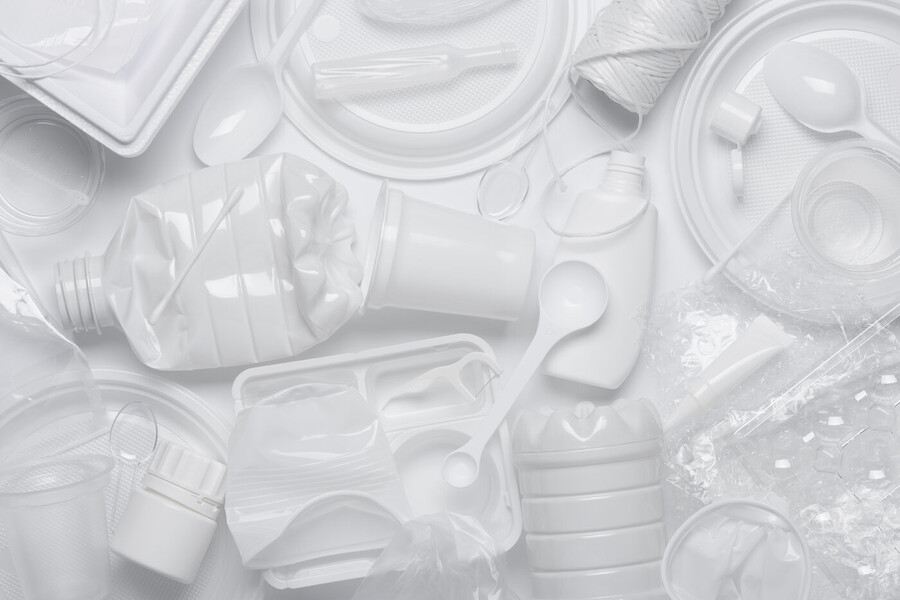The petrochemical industry produced 460 million tons of plastics in 2019. This number is expected to triple by 2060. A wide range of chemicals – such as bisphenols, phthalates, and flame retardants – are routinely added to plastics. Many of these plastic chemicals are known to be harmful, and they do not stay in the plastic material. They can be released during feedstock extraction as well as the production, use, and end-of-life of plastics.
With so much being produced, the potential for harms to environmental health are enormous. Crafting effective public policy to protect against those harms is daunting. A recent report by the PlastChem project, State of the Science on Plastic Chemicals, lays out a roadmap for safer, sustainable policies. Compiling the latest science around plastic chemicals, the report analyzes and identifies hazards and makes key policy recommendations.
Identifying Known Hazards
Industrial chemicals are an intrinsic part of plastics, starting with fossil fuels. Ninety-nine percent of plastic is derived from fossil fuels, and many plastic chemicals are completely unregulated.
The PlastChem project used a hazards-based approach to comprehensively identify known chemical hazards in plastics. The report identified over 16,000 chemicals that are potentially used or present in plastics. Of those, less than 6% are regulated globally. The report used the following criteria to identify hazardous chemicals:

A chemical that is known to exhibit any of these properties is a chemical of concern. Using these criteria, the report found over 4,200 chemicals of concern in plastics. Of these:
- 3,844 have been found to be toxic
- Over 3,600 are unregulated globally
- 340 exhibit at least 3 of the 4 possible hazard criteria
Identifying Unknown Hazards
In addition to known hazards, the impacts of many plastic chemicals are completely unknown. In fact, a significant number of these are non-intentionally added substances (NIAS) — chemicals which can result from impurities, reaction byproducts, and degradation byproducts. Some NIAS are unknown even to the companies that produce the plastics.
With so many unstudied, unregulated, and even unknown chemicals in plastics, the most comprehensive list of known hazards still gives a very incomplete picture. Completing risk assessment on so many chemicals would present many challenges, including immense resource requirements, investments, and technical challenges for establishing robust exposure information (such as measuring levels of plastic chemicals in the environment, wildlife, and humans). In the meantime, without policy changes now, these chemicals will continue to be produced and released into the environment.
The PlastChem report efficiently tackles this problem by analyzing the chemicals by group, rather than individually.
Groups of chemicals that are structurally similar are likely to have similar hazard and exposure properties. If some chemicals in a group have been identified as hazardous, then others in the same group are likely to be similarly hazardous. In this way, many likely, but still unknown, hazards can be identified. The report found the following 15 groups of concern.

Following a groups-based approach, any chemical that falls into one of these groups should be treated as hazardous unless research proves otherwise.
Regulating plastic chemicals in this way will result in more efficient and effective policy. This will also help prevent regrettable substitutions, where a known chemical of concern is removed only to be replaced by an unknown chemical with a similar structure.
Recommendations
Based on their findings, the PlastChem project made four recommendations for policy-makers:
- Regulate plastic chemicals comprehensively and efficiently: This can be accomplished by combining the hazard-based analysis for known chemicals of concern with the groups-based analysis for chemical groups of concern.
- Require transparency on plastic chemicals: The lack of transparency in the chemical composition of plastics results in significant knowledge gaps. Plastics producers should be required to disclose the chemical composition of their products. This requirement should include a “no data, no market” approach. Transparency would help both in facilitating safety assessments and the development of safer plastics.
- Simplify plastics towards safety and sustainability: As noted by the report, many of the plastic chemicals in use serve similar and sometimes non-essential functions. Using fewer and safer chemicals would eliminate unnecessary chemical complexity and make regulating plastic chemicals more efficient.
- Build capacity to create safer and more sustainable plastics: The number of plastic chemicals and polymers on the market outsizes the institutional capacity for testing, assessment, and management at an international, regional, and national level. This capacity should be increased by fostering global knowledge exchanges, providing equal access to technical capabilities, and enhancing institutional resources for an effective management of plastic chemicals.
Negotiators for the UN-led global plastics treaty meet in South Korea in late November for the fifth negotiating session of the treaty process (INC5). This report from the PlastChem project provides negotiators with concrete and actionable steps to address the health harms of plastic chemicals.
For more on the PlastChem report, see our webinar Petrochemicals, Plastics & Health: Will global treaty offer pathway to progress? In the webinar, Dr. Tracey Woodruff highlighted the link between the explosive growth of the petrochemical industry and the rise in various noncommunicable diseases, particularly reproductive cancers in women. Then Dr. Laura Monclús Anglada, co-author of the PlastChem report, explained the report’s methodology and findings.
This organizational blog was produced by CHE's Science Writer, Matt Lilley.

